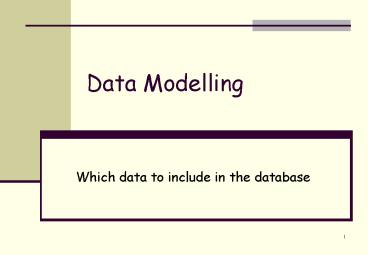Data Modelling - PowerPoint PPT Presentation
1 / 24
Title:
Data Modelling
Description:
Form a model of the enterprise so that the data are accurate ... CAB. 20. Generalizations. Inheritance hierarchies. Employee. Academic. Staff. Support. Staff ... – PowerPoint PPT presentation
Number of Views:14
Avg rating:3.0/5.0
Title: Data Modelling
1
Data Modelling
- Which data to include in the database
2
Aim of Data Modelling
- Form a model of the enterprise so that the data
are accurate and useful. - Yet another form of abstraction.
- First and most important step in database design.
- Requires a good understanding of enterprise being
modeled. - Different methods of data modeling, but the most
widely used is the Entity-Relationship (E-R)
model.
3
Entity-Relationship Model
- Primarily used to specify an external view of the
database. - Recall that the conceptual schema can be created
out of the various external views. - Model the world in terms of
- entities
- relationships between entities
- attributes of entities and relationships.
4
Elements in the E-R Model I
- Entity
- A distinguishable thing, person or event
- Entity set
- A set of entities of the same type
- Relationship
- Representation of the fact that certain entities
are related to each other in a specific way. - Relationship set
- Set of relationships of a given type.
5
Elements in the E-R Model II
- Attributes
- Properties of entities or relationships
- Attribute values are drawn from a given domain or
value set - Attributes may have a set of values (multi-valued
or set-valued attributes). - Key
- An attribute or set of attributes that uniquely
identifies each entity in an entity set.
6
E-R Diagrams
- E-R models can be visualized in E-R diagrams.
- There are different conventions for drawing E-R
diagrams. The following is widely used - Rectangles for entity sets
- Ellipses for attributes
- Diamonds for relationship sets
- Lines to link
- Each component is labelled with its corresponding
name.
7
Example of an E-R Diagram I
- UWI offers many courses.
- Each course has a unique course number and a
name. - Students can enroll in many courses and a course
can be taken by many students. - A student has a name and a unique student number.
- Student obtain grades on courses.
- A course is taught by a single instructor.
8
Example of an E-R Diagram II
c num
Course
c name
Enrol
grade
Teaches
Student
Instructor
s num
i num
s_name
i name
9
Constraints I
- In addition to the entity and relationship sets
and their attributes, during data modelling, one
also identifies constraints. - Examples
- A course is taught by a single instructor.
- No student can enroll for more than 4 courses.
10
Constraints II
- Usually, constraints are not captured in the E-R
diagram and need to be written down. - Two exceptions
- Mapping cardinalities
- Concerns the number of entities involved in a
relationship - Existence dependencies
- Concerns the fact that sometimes the existence of
an entity depends on the existence of another
entity.
11
One-to-One Relationships
- Each entity in E1 is related to at most one
entity in E2 and vice versa. - Example
- A department has only one head and no person can
be head of more than one department.
Head Of
Employee
Department
12
One-to-Many Relationships
- An entity in E2 is related to at most one entity
in E1, but an entity in E1 can be related to many
entities in E2. - Example
- A student has one professor as their supervisor
but a professor may supervise many students.
Super vises
Professor
Student
13
Many-to-many Relationships
- An entity can be related to many entities in the
other set, and vice versa. - Example
- A student can be enrolled in many courses, a
course can have many students enrolled in it.
Enroll
Course
Student
grade
14
Different Conventions
- There are different conventions for mapping
cardinalities. For example, instead of a 1 on
the link, one may use an arrow pointing into the
entity.
15
Existence Dependencies
- An entity x is existence dependent on an entity y
if the existence of x is dependent on the
existence of y. - Y is called the dominant entity x the
subordinate entity. - Example In a personnel database, a dependent
(e.g., child) is existence dependent on the
employee. If the employee is deleted, so is the
dependent.
16
Representation of Subordinate Entities
- Subordinate entities are usually represented in a
double box
Employee
Dependent
17
Some Complicationsto the E-R Diagram
- An entity set may stand in some relationship to
itself. - The links are then labelled with the role that
the entity plays.
Person
Parent
Child
Child-of
18
Multiple Relationships Between Entity Sets
Enroll
Student
Course
Tutor for
19
Ternary Relationships
- A customer may has an account at a particular
branch.
Branch
CAB
Account
Customer
20
Generalizations
- Inheritance hierarchies
Employee
IS A
Support Staff
Academic Staff
21
Specialization
- Sometimes, you want to make a lower level entity
from a higher level entity. However, not every
high-level entity must also be a lower-level
entity.
Student
IS A
Grad Student
22
Aggregation
- Sometimes, you want to treat a relationship as an
entity in its own right, e.g., to allow modelling
of relationships between relationships. - Example
- A customer is assigned a loan manager for every
loan that they get. - Note that the relationship from the login is not
with the customer alone, or with the loan.
23
Aggregation in an E-R Model
borrows
Loan
Customer
Loan-Manager
Employee
24
Problems in Data Modelling
- Should a real-world concept be modelled as an
entity set or a relationship set? - Should a real-world concept be modelled as an
attribute or an entity set? - Is the use of a generalization or aggregation
appropriate?






























